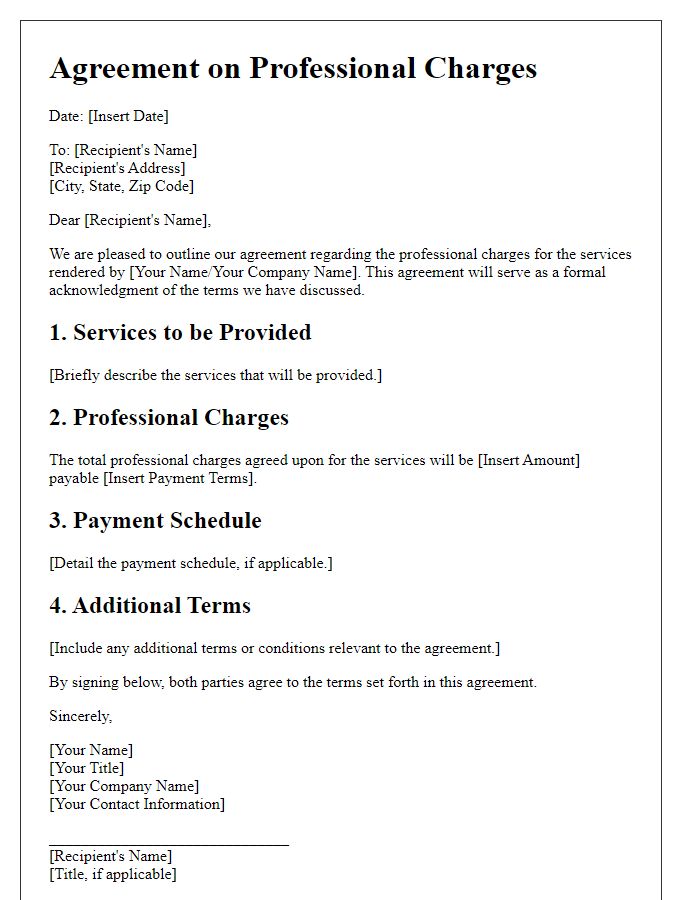Are you looking to establish a clear and professional understanding of fees for services rendered? A well-crafted professional fee agreement can help ensure that both parties are on the same page, avoiding potential misunderstandings down the line. This letter template provides a structured approach to detailing the terms of your agreement, making it easier for you and your clients to navigate discussions about compensation. Dive into this article to discover how to create an effective professional fee agreement that suits your needs!

Introduction and Purpose
A professional fee agreement serves as a crucial document outlining the terms and conditions under which services will be rendered and compensated. This agreement establishes clarity for both parties involved, detailing the expectations, responsibilities, and payment structures related to the professional services provided. By emphasizing transparency, it helps to prevent misunderstandings and disputes, ensuring a streamlined working relationship. Key elements typically included are the scope of services, fee structure, payment schedules, and conditions for termination. Establishing this agreement early in the professional relationship is essential for fostering trust and accountability.
Scope of Services
The Scope of Services for a Professional Fee Agreement outlines the specific tasks and responsibilities that a professional, such as a consultant or contractor, will undertake for a client. This section serves to clearly define the deliverables expected, including essential milestones and timelines associated with the project. For instance, a marketing consultant may offer services such as market research, campaign development, and data analysis, focusing on targeted demographics in a specific region, such as the Midwest United States. Responsibilities will include regular updates (weekly or bi-weekly meetings), written reports outlining progress, and strategic recommendations based on analytical findings. The documentation will also specify any limitations or exclusions from the services provided, ensuring mutual understanding between the professional and the client. Furthermore, it may include provisions for additional services that could be requested by the client, such as social media management or crisis communication strategies, along with estimated costs per service.
Fee Structure and Payment Terms
When establishing a professional fee agreement, a clearly defined fee structure and payment terms are crucial. The fee structure may include hourly rates, fixed project fees, or retainer arrangements, depending on the service provided or industry standards. For example, a legal consultant may charge $250 per hour, while a graphic designer might provide services for a flat fee of $1,500 per project. Payment terms should specify the timeline for payment, such as payment due upon receipt of the invoice or within 30 days. Additionally, late payment penalties, such as a 5% fee for payments received after the due date, can be outlined to encourage timely payment. Clear communication of these terms not only enhances transparency but also helps in maintaining a professional relationship between the parties involved.
Responsibilities and Obligations
Professional fee agreements establish clear expectations between parties involved in a contractual relationship. Key elements include defining responsibilities and obligations of both the service provider and the client. The service provider must fulfill specific duties, such as delivering services according to industry standards, maintaining confidentiality regarding proprietary information, and adhering to deadlines outlined in the agreement. Responsibilities may also encompass providing regular updates and reports on project progress, ensuring compliance with relevant regulations, and obtaining necessary permits for any work that requires them. Meanwhile, the client holds obligations that include timely payment of agreed fees, supplying necessary information and resources, and facilitating access to their premises or personnel as required. Both parties should be aware of potential issues such as delays or changes in project scope, which may necessitate amendments to the agreement. Clear delineation of these responsibilities can prevent misunderstandings and facilitate a smooth working relationship.
Termination and Dispute Resolution
Termination of the professional fee agreement can occur under specific conditions, such as breach of contract, non-payment of fees, or mutual consent. Notice periods, typically ranging from 30 to 90 days, must be adhered to ensure a smooth termination process. Dispute resolution mechanisms should include negotiation steps, mediation by a neutral third party, and, if necessary, arbitration under the rules provided by established organizations, such as the American Arbitration Association. Clear definitions of what constitutes a dispute, along with jurisdiction specifications, ideally in the location where services were rendered, are essential for legal clarity and enforceability. This structured approach ensures that both parties have a clear understanding of their rights and responsibilities in case of an agreement termination or disagreement arising from the professional relationship.













Comments